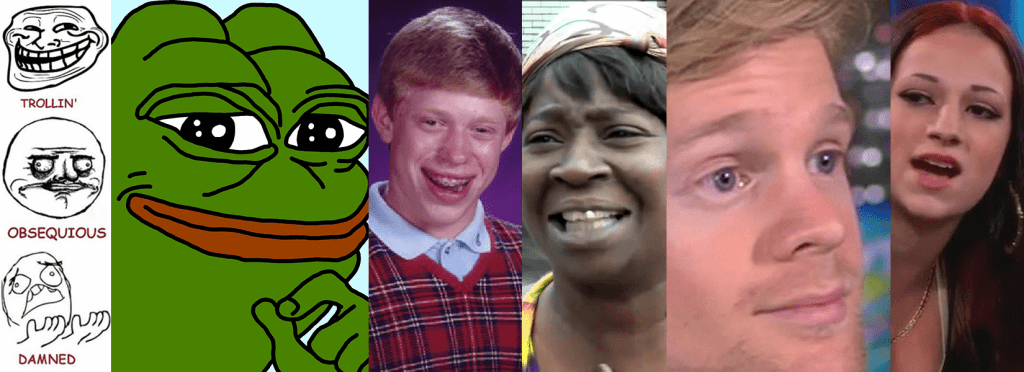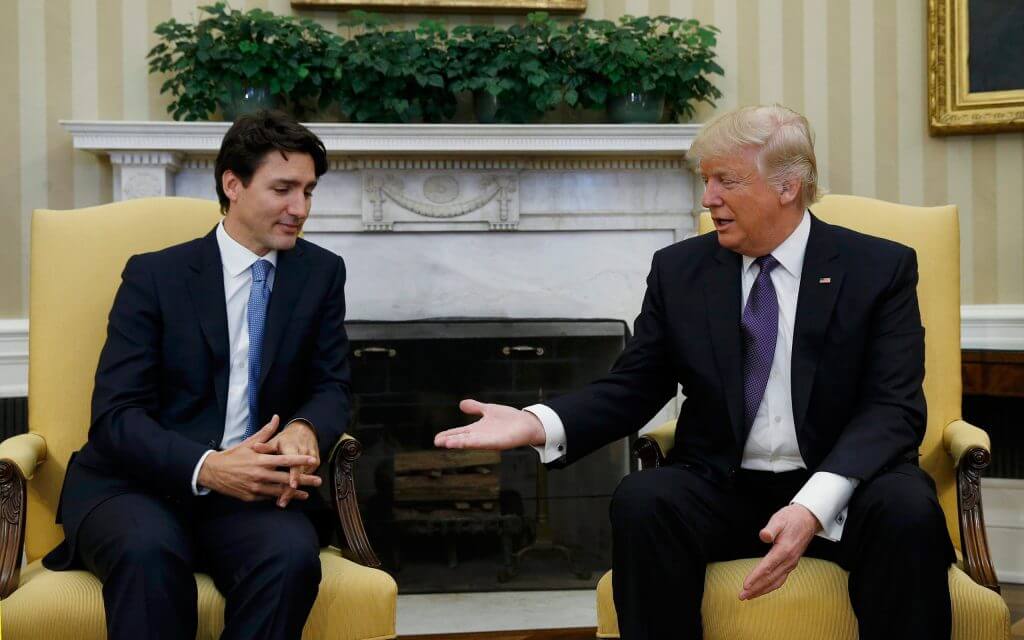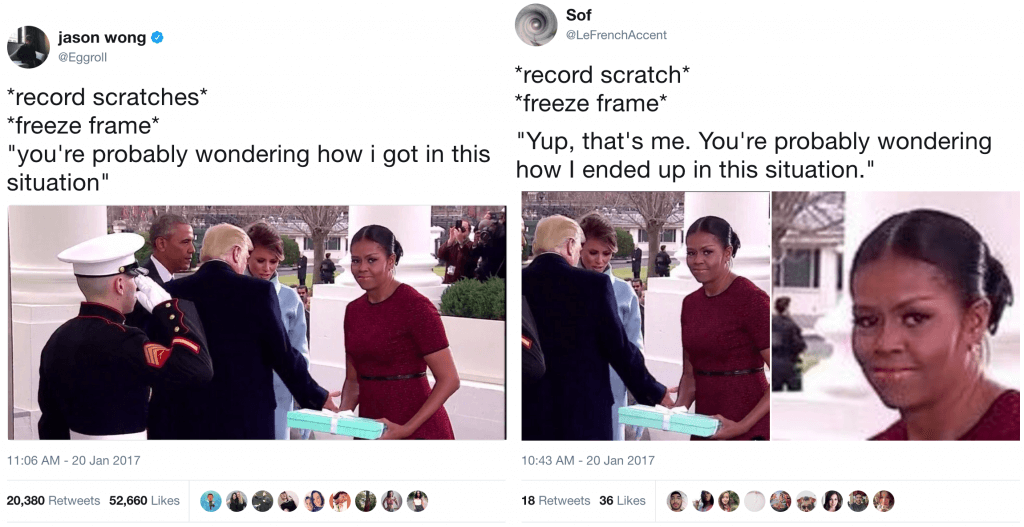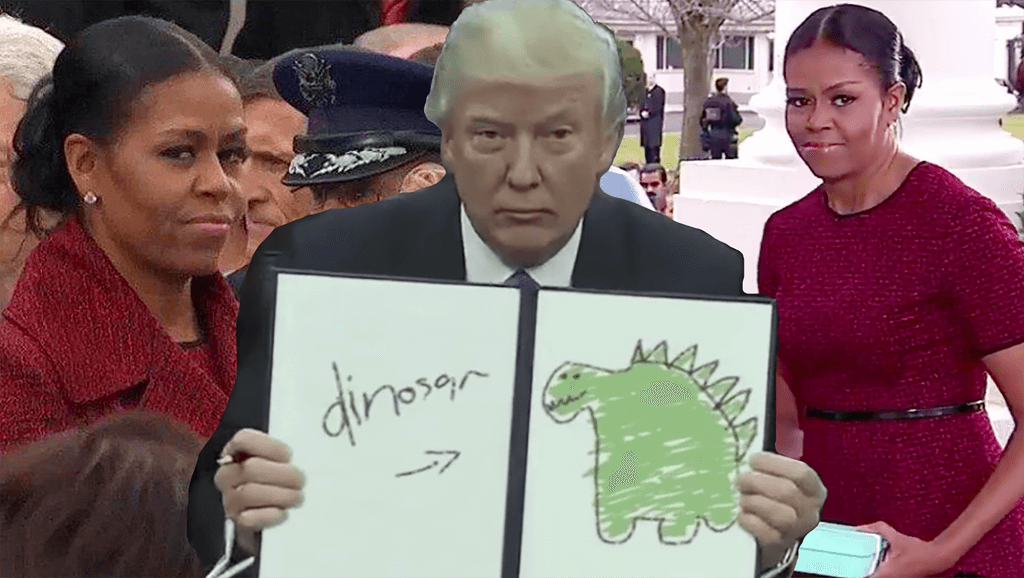Who tells the inside jokes of the internet?
A deep dive into the world of internet memes and their makers
Julianna Garofalo@juliannagaro

In the seconds after Melania Trump handed Michelle Obama a Tiffany box at the 2017 presidential inauguration, Jason Wong—from breakfast at a Vietnamese restaurant in downtown Los Angeles—raced to rewind the livestream he’d been watching on the Twitter app. “My brain clicked,” recalls the 20-year-old. “I wanted to post about it before anybody else did.” Repeatedly pressing his phone’s home and power buttons, Wong—as if handling a game controller—took a burst of screenshots and captured the exact still fit for his caption in mind. With reference to a 1990s movie cliché and a tweet, the meme was born: “*record scratch* *freeze frame* ‘I bet you’re wondering how I got into this situation’” above the former First Lady, upon receiving the present from her successor, staring into camera The Office-style. “It felt like she was asking ‘How did we get into this mess?’” he says of the now widely shared instant known as side-eyeing Michelle Obama. “I could relate and knew others would too.”
Who tells the inside jokes of the internet? Though memes are unavoidable on timelines, dashboards, and newsfeeds alike, the people who actually make them are often unknown with unchecked authority over what captures focus in our attention economy. Wong, with more than one million followers across Tumblr, Twitter, and Instagram, has known the power to “make anything go viral within 48 hours” since high school. Viewing the White House greeting that early January morning through meme-coloured glasses was part of his job: a livelihood that earned him over $250,000 last year, supporting him through college, in founding his own consulting firm, launching an annual meme activity book, and most recently, gifting his mother a Toronto apartment. Meme-makers are hunters on the prowl, describes Nathan Jurgenson in his essay Speaking In Memes, ever-ready to pounce on the world’s most clickable, shareable, likeable, memeable moments. Wong, garnering nearly 100,000 retweets and favourites on his inauguration gag, made the kill.

Derived from the Greek word mimema (meaning “imitated thing”) and coined by Richard Dawkins in his 1976 book The Selfish Gene, a meme is historically defined as a unit of cultural transmission spread through replication with melodies, fashions, and catchphrases as examples. Today, however, the term’s meaning is broad, encompassing the consumer-producer dualism of Web 2.0: content that scatters rapidly from person to person to create a joint cultural experience, generates by various means of repackaging, and informs the social groups in which they propagate. “We’ve developed a kind of meme-literacy,” according to Jurgenson. “We hear retweets in words.”
At their best, memes bring people together and remind the isolated that they aren’t alone. For many, they are created and distributed as “coping mechanisms,” breaking down the hard-to-swallow into playful, punchy, bite-size pieces of media. In this way, how we interpret the world online and off has dangerously shifted: Significance is now equated to virality as the overall narratives of major news events are rewritten by the memes they spawn, dictating which parts resonate and which pass into obscurity. Memes can now inspire empathy by unprecedented means, but we fail to acknowledge where or who they come from. As meme-makers increasingly partner with brands to monetize memes into so-called “ideaviruses” that spread like global infections from consumer to consumer, we must also consider how these young social media influencers can and do abuse their platforms. Within these networks, we depend on a drug and, while readily letting them exploit our addiction, don’t bother to learn our dealers’ names.
***
Viral posts are hard to predict, but when Wong sensed the Michelle Obama meme picking up traction he, for “shits and gigs,” turned on his mobile social media notifications. Within minutes, he remembers, relentless vibration alerts sent his phone off the edge of his coffee table. When he first joined Tumblr in 2012, though, memes and their demand were in infancy. “The things we consider memes now would have not been considered memes back then” and vice-versa, he says. From the original rage comics and Pepe the Frog to early 2010s Bad Luck Brian and Ain’t Nobody Got Time For That to recent White Guy Blinking and Cash Me Ousside girl, he grew up through their evolution. While the forms memes take have drastically changed, Wong reasons, the root of their value will never be substituted: They’re relatable. Bullied in school and troubled with moves between China, the U.S., and Canada as a kid, Wong—now based in California—credits meme creation and curation with his self-discovery. By populating his blog, asian.tumblr.com, with memes that worked to assert his own identity, he attracted an international community of like-minded individuals. If he felt insecure in his body, for instance, a post such as, “I wish we could donate body fat to those in need” would receive over 200,000 reblogs from internet friends affirming they felt the same way.

Jason Wong.
Wong insists the gravity of his influence is not lost on him, but some—including the Reddit user who made a meme encouraging people to heat up spoons in the microwave to more easily scoop hardened ice cream—do abuse their command. “Honestly, I could create fake news or start a religion if I wanted,” he says. When Justin Trudeau met with Donald Trump in February, for example, a meme sparked by a Reuters image in which the prime minister seemingly refuses the president’s handshake told the story of a confrontation between the world leaders. “‘I don’t know where that hand has been’ – Justin Trudeau, probably,” read one popular tweet. Another: “[Trudeau is] cold as ice.” Despite the men being cordial during the photo op, the summit’s alternative narrative was largely accepted as fact, circulating as what the U.K.-based Telegraph called the biggest display of dominance in Canada’s history. “The incredible feature of memes is that they are noticeable among tons of texts on the internet,” clarifies Westminster School of Media lecturer Anastasia Denisova. “They easily go viral and intoxicate the mainstream.”
More than just uniting online communities, memes also establish physical ones. The 3,000-member Toronto Bunz Dank Meme Zone (BDMZ) private Facebook group, for instance, encourages the use of memes to express experiences of marginalization. At monthly meet-ups (called “meme-ups”), users take their interactions from URL to IRL. “In person, I don’t have to be guarded about being queer or having anxiety because I am so open about it [through the memes I post] in the group,” says 24-year-old Lavinia Tea, a BDMZ administrator who characterizes the site as a “safety haven” where harmful biases are challenged by “promoting critical thinking with memes about social justice and sexuality.” Member requests like, “please send anti-mansplaining memes. This one classmate won’t shut up so I need a good laugh,” call for virtual support in the face of tangible oppression. Scrolling through a folder titled “Memes” on her computer desktop, Tea pulls up image macros and GIFs poking fun at panic attacks and breakups made during her own hardships. “This is our way of normalizing our non-mainstream identities and stigmatized struggles,” she says. Without the BDMZ’s strict community standards, though, Tea speculates they would not be protected from the “edgelords” of the web who exist only to shock and offend. In public digital spaces, controversial “normie” (or mainstream) memes are circulated much more invasively with little regard for whose feelings they hurt. For this reason, when a candlelight vigil for Harambe the Gorilla—a meme banned by the group for mocking traditionally Black names and body types—was held at Ryerson University in September 2016, BDMZ members were disappointed but not surprised it drew hundreds in attendance. “It was just a joke,” says Mustafa Malick, the student who organized the memorial and calls arguments the meme promotes racist stereotypes “extremely farfetched.” “People get offended by anything nowadays.”
***
Ten hours after Wong spawned side-eyeing Michelle Obama, a reply appeared in his notification tab—surrounded by an ever-growing collection of heart and looping arrow icons—accusing him of being among the most shameful of cyberspace criminals: a meme thief. “God damn it,” wrote French user Sofiane A.K. “I did it first.” Nearly identical with slight variation in wording, his meme was posted 23 minutes earlier than Wong’s. “[I was annoyed] about my lack of luck,” he explains in an interview. “I did it first but I have a smaller audience so it doesn’t really matter if I did in the end.” While products of personalized creativity, memes also conform to public formulas and scripts that would make the independent design of two identical memes possible: “There is definitely a race to create and only one can survive,” Wong says.
But can a shared element of culture actually belong to an individual? Peaches Monroe—the woman who coined “on fleek” in 2014—thinks so, now seeking compensation via crowdfunding site GoFundMe for the phrase’s use by brands and celebrities. The unspoken rules of our mash-up society built on borrowed ideas, however, reason that such cultural products are forms of commentary that belong to us all. “Once you share a meme, it starts a life of its own, without copyright or signature from the author,” disputes Westminster lecturer Denisova. “It is no longer yours.” In fact, she continues, it never really was because memes are artefacts of popular culture, slang, politics, and so on: They’re “a recycled media unit.”

Though in theory anybody can be a meme-maker, the privilege to infiltrate the public norm is highly conglomerated. Because the most “famous” meme accounts—such as @Dory, @RelatableQuote, and @lifepost—notoriously steal and repost memes in early stages of virality, “there is a definite lack of representation of good content creators,” suggests Wong. While they openly disclaim not owning the content they post, these massively followed entities secure their superiority as meme providers by interfering with any everyday user’s viral momentum, reclaiming it as their own. “They changed absolutely nothing about my tweet, not even the amount of exclamation points at the ends of my sentences,” details user @hamlllton, whose meme of playwright and composer Lin-Manuel Miranda as an unrelenting universe was taken in March. “Mine had around 200 retweets, but in a few minutes that account had thousands.” Kassandra Tate, a 20-year-old Californian, has been acknowledged for the meme since Miranda himself publicly denounced the “joke-steal accounts” on her behalf. “I see people around my college campus sharing the meme [and they] have no idea I made it,” she says. “How amazing is it that with one tweet people all across the world start using the same slang and sharing the same pictures?”
When a price is put on a meme, the sense of entitlement grows. According to Wong, a meme’s worth is determined by its ability to infiltrate everyday conversation while still seeming normal. Marketers thus employ meme-makers to create and share ads disguised as memes that will strew from customer to customer, rather than from brand to customer. Like the mistaken announcement of Best Picture at the Oscars, true memes cannot be forced or manufactured, stemming from moments of off-script authenticity. To serve clients, meme-makers—like Wong and @Daquan of Canada’s most popular meme account—leverage the trust they’ve forged with their fans; the expectation that everything they post is in some way an honest output of their genuine feelings and experiences. The popular “you vs. the guy she tells you not to worry about” template, for instance, is then applied in promoting a Burger King chicken sandwich over a competitor’s instead of the meme’s traditional and organic use by jealous spouses. “It’s all very native on the account,” says Daquan, the 18-year-old from Calgary who reaches more than nine million users on Instagram with branded memes for a living. “Most of the time you can’t even notice it’s an ad.”
***
Once discussion of side-eyeing Michelle Obama had been replaced with crowd size disputes and #AlternativeFacts, Wong’s spiking activity of Twitter impressions steadied. He knew the meme was dead. “It represented a collective feeling toward a specific moment in time,” he says. Once that moment passed, the meme did too. Albeit expiring as quickly as it came alive, the meme made Wong—and the masses it reached—feel better about the swearing in of an unfavourable 45th president of the United States, even if for a brief period.
While memes may work to alleviate some of the pain, they inherently fall far short of a cure. Rather than watching President Trump sign a memorandum to advance construction of the Dakota Access Pipeline after months of Standing Rock protests in January, it was more comforting to see a Photoshopped childlike doodle of a “dinosar” in the executive order’s place. Instead of thinking about the implications of climate change on water resources around the world, it is easier to make light of its significant impact on our ecosystems through perplexed Bill Nye The Science Guy. Laughing at the prospect of World War III is less worrisome than contemplating the potential dire repercussions of the U.S. airstrike on Syria.While this may be the comic relief some seek, these memes also work to numb—convincing many that if they’re meme-ing about it, they’re doing enough. In ignoring where the viral concepts we digest and regurgitate come from, we—symptomatic of a society that avoids investing in the escapism afforded by music, cinema, television—miss the opportunity to understand the source’s effect on how we think and act, playing directly into the hands of those profiting from our disregard.

Though he doesn’t deny the banner fits his job description, like the nuanced difference between a comedian and somebody who tells a lot of jokes, Wong resists his meme-making label. “It’s supposed to be a natural phenomenon. You’re believed to feel connected to the content because it represents you and your thoughts and ideas,” he argues. “Giving yourself a title defeats the purpose. It’s like eating. I eat, but I’m not a food eater.” In this sense, memes have come to express what our pre-internet vocabulary could not: To regularly consume them is to process life through a new language. To be a meme-maker is to have defined the words.
For more technology longreads, pick up a copy of our November/December issue, on newsstands next month! Subscribe to receive it at your doorstep.
Julianna Garofalo is a journalism student at Ryerson University who enjoys writing about cyberculture.